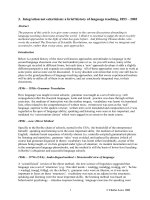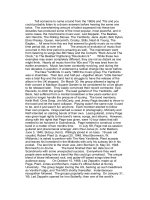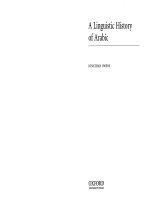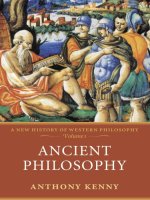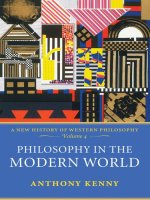Peter frankopan the silk roads a new history of world
Bạn đang xem bản rút gọn của tài liệu. Xem và tải ngay bản đầy đủ của tài liệu tại đây (7.48 MB, 444 trang )
THESILKROADS
THESILKROADS
ANewHistoryoftheWorld
PETERFRANKOPAN
ToKatarina,Flora,FrancisandLuke
WehaltedinthecountryofatribeofTürks…wesawagroupwhoworshipsnakes,agroupwho
worshipfish,andagroupwhoworshipcranes.
IbnFa lān’sVoyagetotheVolgaBulghars
I,PresterJohn,amthelordoflords,andIsurpassallthekingsoftheentireworldinwealth,virtue
and power … Milk and honey flow freely in our lands; poison can do no harm, nor do any noisy
frogscroak.Therearenoscorpions,noserpentscreepinginthegrass.
PurportedletterofPresterJohntoRomeandConstantinople,twelfthcentury
Hehasaverylargepalace,entirelyroofedwithfinegold.
ChristopherColumbus’researchnotesontheGreatKhanoftheEast,latefifteenthcentury
If we do not make relatively small sacrifices, and alter our policy, in Persia now, we shall both
endangerourfriendshipwithRussiaandfindinacomparativelynearfuture…asituationwhereour
veryexistenceasanEmpirewillbeatstake.
SirGeorgeClerktoSirEdwardGrey,BritishForeignSecretary,
21July1914
Thepresidentwouldwinevenifwesatarounddoingnothing.
ChiefofStafftoNursultanNazarbayev,PresidentofKazakhstan,
shortlybefore2005elections
CONTENTS
NoteonTransliteration
Preface
1 TheCreationoftheSilkRoad
2 TheRoadofFaiths
3 TheRoadtoaChristianEast
4 TheRoadtoRevolution
5 TheRoadtoConcord
6 TheRoadofFurs
7 TheSlaveRoad
8 TheRoadtoHeaven
9 TheRoadtoHell
10 TheRoadofDeathandDestruction
11 TheRoadofGold
12 TheRoadofSilver
13 TheRoadtoNorthernEurope
14 TheRoadtoEmpire
15 TheRoadtoCrisis
16 TheRoadtoWar
17 TheRoadofBlackGold
18 TheRoadtoCompromise
19 TheWheatRoad
20 TheRoadtoGenocide
21 TheRoadofColdWarfare
22 TheAmericanSilkRoad
23 TheRoadofSuperpowerRivalry
24 TheRoadtoCatastrophe
25 TheRoadtoTragedy
Conclusion:TheNewSilkRoad
Notes
Acknowledgements
Index
NOTEONTRANSLITERATION
Historians tend to become anxious over the issue of transliteration. In a book such as this one that
drawsonprimarysourceswrittenindifferentlanguages,itisnotpossibletohaveaconsistentruleon
propernames.NameslikeJoãoandIvanareleftintheiroriginalforms,whileFernandoandNikolai
arenotandbecomeFerdinandandNicholas.Asamatterofpersonalpreference,IuseGenghisKhan,
Trotsky, Gaddafi and Teheran even though other renditions might be more accurate; on the other
hand, I avoid western alternatives for Beijing and Guangzhou. Places whose names change are
particularlydifficult.IrefertothegreatcityontheBosporusasConstantinopleuptotheendofthe
FirstWorldWar,atwhichpointIswitchtoIstanbul;IrefertoPersiauntilthecountry’sformalchange
ofnametoIranin1935.Iaskforforbearancefromthereaderwhodemandsconsistency.
PREFACE
Asachild,oneofmymostprizedpossessionswasalargemapoftheworld.Itwaspinnedonthewall
bymybed,andIwouldstareatiteverynightbeforeIwenttosleep.Beforelong,Ihadmemorisedthe
namesandlocationsofallthecountries,notingtheircapitalcities,aswellastheoceansandseas,and
theriversthatflowedintothem;thenamesofmajormountainrangesanddeserts,writteninurgent
italics,thrilledwithadventureanddanger.
BythetimeIwasateenager,Ihadbecomeuneasyabouttherelentlesslynarrowgeographicfocus
ofmyclassesatschool,whichconcentratedsolelyonwesternEuropeandtheUnitedStatesandleft
mostoftherestoftheworlduntouched.WehadbeentaughtabouttheRomansinBritain;theNorman
conquest of 1066; Henry VIII and the Tudors; the American War of Independence; Victorian
industrialisation;thebattleoftheSomme;andtheriseandfallofNaziGermany.Iwouldlookupat
mymapandseehugeregionsoftheworldthathadbeenpassedoverinsilence.
For my fourteenth birthday my parents gave me a book by the anthropologist Eric Wolf, which
reallylitthetinder.Theacceptedandlazyhistoryofcivilisation,wroteWolf,isonewhere‘Ancient
Greece begat Rome, Rome begat Christian Europe, Christian Europe begat the Renaissance, the
RenaissancetheEnlightenment,theEnlightenmentpoliticaldemocracyandtheindustrialrevolution.
Industry crossed with democracy in turn yielded the United States, embodying the rights to life,
libertyandthepursuitofhappiness.’1IimmediatelyrecognisedthatthiswasexactlythestorythatI
hadbeentold:themantraofthepolitical,culturalandmoraltriumphofthewest.Butthisaccountwas
flawed;therewerealternativewaysoflookingathistory–onesthatdidnotinvolvelookingatthe
pastfromtheperspectiveofthewinnersofrecenthistory.
Iwashooked.Itwassuddenlyobviousthattheregionswewerenotbeingtaughtabouthadbecome
lost,suffocatedbytheinsistentstoryoftheriseofEurope.Ibeggedmyfathertotakemetoseethe
HerefordMappaMundi,whichlocatedJerusalemasitsfocusandmid-point,withEnglandandother
westerncountriesplacedofftooneside,allbutirrelevancies.WhenIreadaboutArabgeographers
whose works were accompanied by charts that seemed upside down and put the Caspian Sea at its
centre, I was transfixed – as I was when I found out about an important medieval Turkish map in
IstanbulthathadatitsheartacitycalledBalāsāghūn,whichIhadneverevenheardof,whichdidnot
appear on any maps, and whose very location was uncertain until recently, and yet was once
consideredthecentreoftheworld.2
IwantedtoknowmoreaboutRussiaandCentralAsia,aboutPersiaandMesopotamia.Iwantedto
understandtheoriginsofChristianitywhenviewedfromAsia;andhowtheCrusadeslookedtothose
living in the great cities of the Middle Ages – Constantinople, Jerusalem, Baghdad and Cairo, for
example;Iwantedtolearnaboutthegreatempiresoftheeast,abouttheMongolsandtheirconquests;
andtounderstandhowtwoworldwarslookedwhenviewednotfromFlandersortheeasternfront,
butfromAfghanistanandIndia.
It was extraordinarily fortunate therefore that I was able to learn Russian at school, where I was
taughtbyDickHaddon,abrilliantmanwhohadservedinNavalIntelligenceandbelievedthattheway
to understand the Russian language and dusha, or soul, was through its sparkling literature and its
peasantmusic.IwasevenmorefortunatewhenheofferedtogiveArabiclessonstothosewhowere
interested, introducing half a dozen of us to Islamic culture and history, and immersing us in the
beautyofclassicalArabic.Theselanguageshelpedunlockaworldwaitingtobediscovered,or,asI
soonrealised,toberediscoveredbythoseofusinthewest.
Today,muchattentionisdevotedtoassessingthelikelyimpactofrapideconomicgrowthinChina,
wheredemandforluxurygoodsisforecasttoquadrupleinthenextdecade,ortoconsideringsocial
change in India, where more people have access to a mobile phone than to a flushing toilet.3 But
neitheroffersthebestvantagepointtoviewtheworld’spastanditspresent.Infact,formillennia,it
wastheregionlyingbetweeneastandwest,linkingEuropewiththePacificOcean,thatwastheaxis
onwhichtheglobespun.
The halfway point between east and west, running broadly from the eastern shores of the
MediterraneanandtheBlackSeatotheHimalayas,mightseemanunpromisingpositionfromwhich
to assess the world. This is a region that is now home to states that evoke the exotic and the
peripheral, like Kazakhstan and Uzbekistan, Kyrgyzstan and Turkmenistan, Tajikistan and the
countriesoftheCaucasus;itisaregionassociatedwithregimesthatareunstable,violentandathreat
tointernationalsecurity,likeAfghanistan,Iran,IraqandSyria,orillversedinthebestpracticesof
democracy,likeRussiaandAzerbaijan.Overall,itappearstobearegionthatishometoaseriesof
failedorfailingstates,ledbydictatorswhowinimpossiblylargemajoritiesinnationalelectionsand
whosefamiliesandfriendscontrolsprawlingbusinessinterests,ownvastassetsandwieldpolitical
power.Theyareplaceswithpoorrecordsonhumanrights,wherefreedomofexpressioninmatters
offaith,conscienceandsexualityislimited,andwherecontrolofthemediadictateswhatdoesand
whatdoesnotappearinthepress.4
Whilesuchcountriesmayseemwildtous,thesearenobackwaters,noobscurewastelands.Infact
thebridgebetweeneastandwestistheverycrossroadsofcivilisation.Farfrombeingonthefringe
of global affairs, these countries lie at its very centre – as they have done since the beginning of
history.ItwasherethatCivilisationwasborn,andwheremanybelievedMankindhadbeencreated–
in the Garden of Eden, ‘planted by the Lord God’ with ‘every tree that is pleasant to the sight and
good for food’, which was widely thought to be located in the rich fields between the Tigris and
Euphrates.5
It was in this bridge between east and west that great metropolises were established nearly
5,000yearsago,wherethecitiesofHarappaandMohenjo-darointheIndusvalleywerewondersof
theancientworld,withpopulationsnumberinginthetensofthousandsandstreetsconnectingintoa
sophisticatedsewagesystemthatwouldnotberivalledinEuropeforthousandsofyears.6Othergreat
centres of civilisation such as Babylon, Nineveh, Uruk and Akkad in Mesopotamia were famed for
theirgrandeurandarchitecturalinnovation.OneChinesegeographer,meanwhile,writingmorethan
twomillenniaago,notedthattheinhabitantsofBactria,centredontheOxusriverandnowlocatedin
northernAfghanistan,werelegendarynegotiatorsandtraders;itscapitalcitywashometoamarket
whereahugerangeofproductswereboughtandsold,carriedfromfarandwide.7
Thisregioniswheretheworld’sgreatreligionsburstintolife,whereJudaism,Christianity,Islam,
BuddhismandHinduismjostledwitheachother.Itisthecauldronwherelanguagegroupscompeted,
where Indo-European, Semitic and Sino-Tibetan tongues wagged alongside those speaking Altaic,
Turkic and Caucasian. This is where great empires rose and fell, where the after-effects of clashes
betweenculturesandrivalswerefeltthousandsofmilesaway.Standinghereopenedupnewwaysto
viewthepastandshowedaworldthatwasprofoundlyinterconnected,wherewhathappenedonone
continenthadanimpactonanother,wheretheafter-shocksofwhathappenedonthesteppesofCentral
Asia could be felt in North Africa, where events in Baghdad resonated in Scandinavia, where
discoveriesintheAmericasalteredthepricesofgoodsinChinaandledtoasurgeindemandinthe
horsemarketsofnorthernIndia.
Thesetremorswerecarriedalonganetworkthatfansoutineverydirection,routesalongwhich
pilgrimsandwarriors,nomadsandmerchantshavetravelled,goodsandproducehavebeenbought
andsold,andideasexchanged,adaptedandrefined.Theyhavecarriednotonlyprosperity,butalso
death and violence, disease and disaster. In the late nineteenth century, this sprawling web of
connectionswasgivenanamebyaneminentGermangeologist,FerdinandvonRichthofen(uncleof
theFirstWorldWarflyingacethe‘RedBaron’)thathasstuckeversince:‘Seidenstraßen’–theSilk
Roads.8
These pathways serve as the world’s central nervous system, connecting peoples and places
together,butlyingbeneaththeskin,invisibletothenakedeye.Justasanatomyexplainshowthebody
functions, understanding these connections allows us to understand how the world works. And yet,
despitetheimportanceofthispartoftheworld,ithasbeenforgottenbymainstreamhistory.Inpart,
thisisbecauseofwhathasbeencalled‘orientalism’–thestridentandoverwhelminglynegativeview
oftheeastasundevelopedandinferiortothewest,andthereforeunworthyofseriousstudy.9 But it
alsostemsfromthefactthatthenarrativeofthepasthasbecomesodominantandwellestablished
that there is no place for a region that has long been seen as peripheral to the story of the rise of
Europeandofwesternsociety.
Today, Jalalabad and Herat in Afghanistan, Fallujah and Mosul in Iraq or Homs and Aleppo in
Syria seem synonymous with religious fundamentalism and sectarian violence. The present has
washedawaythepast:gonearethedayswhenthenameofKabulconjuredupimagesofthegardens
planted and tended by the great Bābur, founder of the Mughal Empire in India. The Bagh-i-Wafa
(‘Garden of Fidelity’) included a pool surrounded by orange and pomegranate trees and a clover
meadow–ofwhichBāburwasextremelyproud:‘Thisisthebestpartofthegarden,amostbeautiful
sightwhentheorangestakecolour.Trulythatgardenisadmirablysituated!’10
In the same way, modern impressions about Iran have obscured the glories of its more distant
historywhenitsPersianpredecessorwasabywordforgoodtasteineverything,fromthefruitserved
at dinner, to the stunning miniature portraits produced by its legendary artists, to the paper that
scholarswroteon.AbeautifullyconsideredworkwrittenbySimiNīshāpūrī,alibrarianfromMashad
in eastern Iran around 1400, records in careful detail the advice of a book lover who shared his
passion.Anyonethinkingofwriting,hecounselssolemnly,shouldbeadvisedthatthebestpaperfor
calligraphy is produced in Damascus, Baghdad or Samarkand. Paper from elsewhere ‘is generally
rough,blotchesandisimpermanent’.Bearinmind,hecautions,thatitisworthgivingpaperaslight
tint before committing ink to it, ‘because white is hard on the eyes and the master calligraphic
specimensthathavebeenobservedhaveallbeenontintedpaper ’.11
Placeswhosenamesareallbutforgottenoncedominated,suchasMerv,describedbyonetenthcentury geographer as a ‘delightful, fine, elegant, brilliant, extensive and pleasant city’, and ‘the
mother of the world’; or Rayy, not far from modern Teheran, which to another writer around the
sametimewassogloriousastobeconsidered‘thebridegroomoftheearth’andtheworld’s‘most
beautifulcreation’.12DottedacrossthespineofAsia,thesecitieswerestrunglikepearls,linkingthe
PacifictotheMediterranean.
Urbancentresspurredeachotheron,withrivalrybetweenrulersandelitespromptingevermore
ambitious architecture and spectacular monuments. Libraries, places of worship, churches and
observatoriesofimmensescaleandculturalinfluencedottedtheregion,connectingConstantinopleto
Damascus, Isfahan, Samarkand, Kabul and Kashgar. Cities such as these became home to brilliant
scholarswhoadvancedthefrontiersoftheirsubjects.Thenamesofonlyasmallhandfularefamiliar
today–menlikeIbnSīnā,betterknownasAvicenna,al-Bīrūnīandal-Khwārizmi–giantsinthefields
of astronomy and medicine; but there were many more besides. For centuries before the early
modern era, the intellectual centres of excellence of the world, the Oxfords and Cambridges, the
HarvardsandYales,werenotlocatedinEuropeorthewest,butinBaghdadandBalkh,Bukharaand
Samarkand.
There was good reason why the cultures, cities and peoples who lived along the Silk Roads
developed and advanced: as they traded and exchanged ideas, they learnt and borrowed from each
other,stimulatingfurtheradvancesinphilosophy,thesciences,languageandreligion.Progresswas
essential,asoneoftherulersofthekingdomofZhaoinnorth-easternChinaatoneextremityofAsia
morethan2,000yearsagoknewalltoowell.‘Atalentforfollowingthewaysofyesterday’,declared
King Wu-ling in 307 BC, ‘is not sufficient to improve the world of today.’13 Leaders in the past
understoodhowimportantitwastokeepupwiththetimes.
The mantle of progress shifted, however, in the early modern period as a result of two great
maritimeexpeditionsthattookplaceattheendofthefifteenthcentury.Inthecourseofsixyearsinthe
1490s,thefoundationswerelaidforamajordisruptiontotherhythmoflong-establishedsystemsof
exchange.FirstChristopherColumbuscrossedtheAtlantic,pavingthewayfortwogreatlandmasses
thatwerehithertountouchedtoconnecttoEuropeandbeyond;then,justafewyearslater,Vascoda
GamasuccessfullynavigatedthesoutherntipofAfrica,sailingontoIndia,openingnewsearoutesin
the process. The discoveries changed patterns of interaction and trade, and effected a remarkable
change in the world’s political and economic centre of gravity. Suddenly, western Europe was
transformed from its position as a regional backwater into the fulcrum of a sprawling
communication,transportationandtradingsystem:atastroke,itbecamethenewmid-pointbetween
eastandwest.
TheriseofEuropesparkedafiercebattleforpower–andforcontrolofthepast.Asrivalssquared
uptoeachother,historywasreshapedtoemphasisetheevents,themesandideasthatcouldbeusedin
theideologicalclashesthatragedalongsidethestruggleforresourcesandforcommandofthesea
lanes. Busts were made of leading politicians and generals wearing togas to make them look like
Roman heroes of the past; magnificent new buildings were constructed in grand classical style that
appropriatedthegloriesoftheancientworldastheirowndirectantecedents.Historywastwistedand
manipulated to create an insistent narrative where the rise of the west was not only natural and
inevitable,butacontinuationofwhathadgonebefore.
Manystoriessetmeonthewaytolookingattheworld’spastinadifferentway.Butonestoodoutin
particular.GreekmythologyhaditthatZeus,fatherofthegods,releasedtwoeagles,oneateachend
oftheearth,andcommandedthemtoflytowardseachother.Asacredstone,theomphalos–thenavel
oftheworld–wasplacedwheretheymet,toenablecommunicationwiththedivine.Ilearntlaterthat
theconceptofthisstonehaslongbeenasourceoffascinationforphilosophersandpsychoanalysts.14
IremembergazingatmymapwhenIfirstheardthistale,wonderingwheretheeagleswouldhave
met.IimaginedthemtakingofffromtheshoresofthewesternAtlanticandthePacificcoastofChina
and heading inland. The precise position changed, depending where I placed my fingers to start
measuringequaldistancesfromeastandwest.ButIalwaysendedupsomewherebetweentheBlack
Sea and the Himalayas. I would lie awake at night, pondering the map on my bedroom wall, Zeus’
eaglesandthehistoryofaregionthatwasnevermentionedinthebooksthatIread–anddidnothave
aname.
Notsolongago,EuropeansdividedAsiaintothreebroadzones–theNear,MiddleandFarEast.
Yet whenever I heard or read about present-day problems as I was growing up, it seemed that the
second of these, the Middle East, had shifted in meaning and even location, being used to refer to
Israel, Palestine and the surrounding area, and occasionally to the Persian Gulf. And I could not
understandwhyIkeptbeingtoldoftheimportanceoftheMediterraneanasacradleofcivilisation,
when it seemed so obvious that this was not where civilisation had really been forged. The real
crucible,the‘Mediterranean’initsliteralmeaning–thecentreoftheworld–wasnotaseaseparating
EuropeandNorthAfrica,butrightintheheartofAsia.
My hope is that I can embolden others to study peoples and places that have been ignored by
scholarsforgenerationsbyopeningupnewquestionsandnewareasofresearch.Ihopetoprompt
newquestionstobeaskedaboutthepast,andfortruismstobechallengedandscrutinised.Aboveall,I
hopetoinspirethosewhoreadthisbooktolookathistoryinadifferentway.
WorcesterCollege,Oxford
April2015
1
TheCreationoftheSilkRoad
Fromthebeginningoftime,thecentreofAsiawaswhereempiresweremade.Thealluviallowlands
ofMesopotamia,fedbytheTigrisandEuphrates,providedthebasisforcivilisationitself–foritwas
in this region that the first towns and cities took shape. Systematised agriculture developed in
Mesopotamia and across the whole of the ‘Fertile Crescent’, a band of highly productive land with
accesstoplentifulwater,stretchingfromthePersianGulftotheMediterraneancoast.Itwasherethat
some of the first recorded laws were disseminated nearly 4,000 years ago by Hammurabi, King of
Babylon, who detailed his subjects’ obligations and set out fierce punishments for their
transgressions.1
Althoughmanykingdomsandempiressprangupfromthiscrucible,thegreatestofallwasthatof
thePersians.ExpandingquicklyinthesixthcenturyBCfromahomelandinwhatisnowsouthernIran,
thePersianscametodominatetheirneighbours,reachingtheshoresoftheAegean,conqueringEgypt
and expanding eastwards as far as the Himalayas. Their success owed much to their openness, to
judge from the Greek historian Herodotus. ‘The Persians are greatly inclined to adopt foreign
customs,’ he wrote: the Persians were prepared to abandon their own style of dress when they
concludedthatthefashionsofadefeatedfoeweresuperior,leadingthemtoborrowstylesfromthe
MedesaswellasfromtheEgyptians.2
ThewillingnesstoadoptnewideasandpracticeswasanimportantfactorinenablingthePersians
tobuildanadministrativesystemthatallowedthesmoothrunningofanempirewhichincorporated
many different peoples. A highly educated bureaucracy oversaw the efficient administration of the
day-to-day life of the empire, recording everything from payments made to workers serving the
royal household, to validating the quality and quantity of goods bought and sold in market places;
theyalsotookchargeofthemaintenanceandrepairofaroadsystemcriss-crossingtheempirethat
wastheenvyoftheancientworld.3
AroadnetworkthatlinkedthecoastofAsiaMinorwithBabylon,SusaandPersepolisenableda
distanceofmorethan1,600milestobecoveredinthecourseofaweek,anachievementviewedwith
wonder by Herodotus, who noted that neither snow, rain, heat nor darkness could slow the speedy
transmission of messages.4 Investment in agriculture and the development of pioneering irrigation
techniquestoimprovecropyieldshelpednurturethegrowthofcitiesbyenablingincreasinglylarge
populationstobesupportedfromsurroundingfields–notonlyintherichagriculturallandstoeither
side of the Tigris and Euphrates, but also in valleys served by the mighty Oxus and Iaxartes rivers
(nowknownastheAmyDaryaandSyrDarya),aswellasintheNiledeltaafteritscapturebyPersian
armiesin525 BC.ThePersianEmpirewasalandofplentythatconnectedtheMediterraneanwiththe
heartofAsia.
Persiapresenteditselfasabeaconofstabilityandfairness,asatrilingualinscriptionhewnintoa
clifffaceatBehistundemonstrates.WritteninPersian,ElamiteandAkkadian,itrecordshowDarius
theGreat,oneofPersia’smostfamousrulers,putdownrevoltsanduprisings,drovebackinvasions
fromabroadandwrongedneitherthepoornorthepowerful.Keepthecountrysecure,theinscription
commands, and look after the people righteously, for justice is the bedrock of the kingdom.5
Toleranceofminoritieswaslegendary,withonePersianrulerreferredtoasthe‘Messiah’,andthe
onewhomthe‘Lord,theGodofHeaven’hadblessed,astheresultofhispoliciesthatincludedthe
releaseoftheJewsfromtheirBabylonianexile.6
Trade flourished in ancient Persia, providing revenues that allowed rulers to fund military
expeditionstargetinglocationsthatbroughtyetmoreresourcesintotheempire.Italsoenabledthem
to indulge notoriously extravagant tastes. Spectacular buildings were erected in the huge cities of
Babylon, Persepolis, Pasargadae and Susa, where King Darius built a magnificent palace using the
highest-qualityebonyandsilverfromEgyptandcedarfromLebanon,finegoldfromBactria,lapis
and cinnabar from Sogdiana, turquoise from Khwarezm and ivory from India.7 The Persians were
famousfortheirloveofpleasureand,accordingtoHerodotus,onlyhadtohearofanewluxuryto
yearntoindulgeit.8
Underpinning the commercial commonwealth was an aggressive military that helped extend the
frontiers, but was also needed to defend them. Persia faced persistent problems from the north, a
world dominated by nomads who lived with their livestock on semi-arid grassland belts, known as
steppes,stretchingfromtheBlackSeaacrossCentralAsiaasfarasMongolia.Thesenomadswere
famedfortheirferocity–theyweresaidtodrinkthebloodoftheirenemiesandmakeclothesoftheir
scalps, and in some cases to eat the flesh of their own fathers. Interaction with the nomads was
complex though, for despite stock descriptions of them as chaotic and unpredictable, they were
importantpartnersinthesupplyofanimals,andespeciallyfinehorses.Butthenomadscouldbethe
causeofdisaster,suchaswhenCyrustheGreat,thearchitectofthePersianEmpireinthe6thcentury
BC,waskilledtryingtosubjugatetheScythians;hisheadwasthencarriedaroundinaskinfilledwith
blood,saidonewriter,sothatthethirstforpowerthathadinspiredhimcouldnowbequenched.9
Nevertheless, this was a rare setback that did not stall Persia’s expansion. Greek commanders
lookedeastwithacombinationoffearandrespect,seekingtolearnfromthePersians’tacticsonthe
battlefieldandtoadopttheirtechnology.AuthorslikeAeschylususedsuccessesagainstthePersians
as a way of celebrating military prowess and of demonstrating the favour of the gods,
commemoratingheroicresistancetotheattemptedinvasionsofGreeceinepicplaysandliterature.10
‘IhavecometoGreece,’saysDionysusintheopeninglinesoftheBacchae,fromthe‘fabulously
wealthy East’, a place where Persia’s plains are bathed in sunshine, where Bactria’s towns are
protectedbywalls,andwherebeautifullyconstructedtowerslookoutovercoastalregions.Asiaand
theEastwerethelandsthatDionysus‘setdancing’withthedivinemysterieslongbeforethoseofthe
Greeks.11
NonewasakeenerstudentofsuchworksthanAlexanderofMacedon.Whenhetookthethronein336
BC following the assassination of his father, the brilliant King Philip, there was no question about
whichdirectiontheyounggeneralwouldheadinhissearchforglory.Notforamomentdidhelook
toEurope,whichofferednothingatall:nocities,noculture,noprestige,noreward.ForAlexander,
asforallancientGreeks,culture,ideasandopportunities–aswellasthreats–camefromtheeast.It
wasnosurprisethathisgazefellonthegreatestpowerofantiquity:Persia.
AfterdislodgingthePersiangovernorsofEgyptinalightningstrikein331 BC,Alexandersetoff
foranall-outassaultontheempire’sheartlands.Thedecisiveconfrontationtookplacelaterin331on
thedustyplainsofGaugamela,nearthemoderntownofErbilinIraqiKurdistan,whereheinflicteda
spectacular defeat on the vastly superior Persian army under the command of Darius III – perhaps
becausehewasfullyrefreshedafteragoodnight’ssleep:accordingtoPlutarch,Alexanderinsisted
on resting before engaging the enemy, sleeping so deeply that his concerned commanders had to
shakehimawake.Dressinginhisfavouredoutfit,heputonafinehelmet,sopolishedthat‘itwasas
brightasthemostrefinedsilver ’,graspedatrustedswordinhisrighthandandledhistroopstoa
crushingvictorythatopenedthegatesofanempire.12
TutoredbyAristotle,Alexanderhadbeenbroughtupwithhighhopesrestingonhisshoulders.He
did not disappoint. After the Persian armies had been shattered at Gaugamela, Alexander advanced
east. One city after another surrendered to him as he took over the territories controlled by his
defeated rivals. Places of legendary size, wealth and beauty fell before the young hero. Babylon
surrendered, its inhabitants covering the road leading to the great city with flowers and garlands,
while silver altars heaped with frankincense and perfumes were placed on either side. Cages with
lionsandleopardswerebroughttobepresentedasgifts.13Beforelong,allthepointsalongtheRoyal
RoadthatlinkedthemajorcitiesofPersiaandthecommunicationnetworkthatconnectedthecoastof
AsiaMinorwithCentralAsiahadbeentakenbyAlexanderandhismen.
Although some modern scholars have dismissed him as a ‘drunken juvenile thug’, Alexander
appears to have had a surprisingly delicate touch when it came to dealing with newly conquered
territoriesandpeoples.14Hewasoftenemollientwhenitcametolocalreligiousbeliefsandpractices,
showing tolerance and also respect: for example, he was reportedly upset by the way the tomb of
CyrustheGreathadbeendesecrated,andnotonlyrestoreditbutpunishedthosewhohaddefiledthe
shrine.15AlexanderensuredthatDariusIIIwasgivenafuneralbefittinghisrankandburiedalongside
otherPersianrulersafterhisbodyhadbeenfounddumpedinawagonfollowinghismurderbyone
ofhisownlieutenants.16
Alexanderwasalsoabletodrawmoreandmoreterritoryunderhisswaybecausehewaswillingto
relyonlocalelites.‘IfwewishnotjusttopassthroughAsiabuttoholdit,’heispurportedtohave
said,‘wemustshowclemencytothesepeople;itistheirloyaltywhichwillmakeourempirestable
andpermanent.’17Localofficialsandoldeliteswereleftinplacetoadministertownsandterritories
that were conquered. Alexander himself took to adopting traditional titles and wearing Persian
clothingtounderlinehisacceptanceoflocalcustoms.Hewaskeentoportrayhimselfnotsomuchas
an invading conqueror, but as the latest heir of an ancient realm – despite howls of derision from
thosewhotoldallwhowouldlistenthathehadbroughtmiseryandsoakedthelandwithblood.18
ItisimportanttorememberthatmuchofourinformationaboutAlexander ’scampaigns,successes
andpoliciesderivesfromlaterhistorians,whoseaccountsareoftenhighlyidealisedandbreathless
withenthusiasminthecoverageoftheyounggeneral’sexploits.19Nevertheless,evenifweneedtobe
cautious about the way the collapse of Persia is covered in the sources, the speed with which
Alexanderkeptextendingthefrontiersfurthereasttellsitsownstory.Hewasanenergeticfounderof
newcities,usuallynamedafterhimself,thatarenowmoreoftenknownbyothernames,suchasHerat
(Alexandria in Aria), Kandahar (Alexandria in Arachosia) and Bagram (Alexandria ad Caucasum).
Theconstructionofthesestagingposts–andthereinforcementofothersfurthernorth,stretchingto
theFerganavalley–werenewpointsrunningalongthespineofAsia.
New cities with powerful defences, as well as standalone strongholds and forts, were primarily
built to defend against the threat posed by tribes of the steppes who were adept at launching
devastating attacks on rural communities. Alexander ’s programme of fortification was designed to
protectnewareasthathadonlyrecentlybeenconquered.Similarconcernsmetwithsimilarresponses
further east at precisely this time. The Chinese had already developed a concept of huaxia,
representing the civilised world, set against the challenges of the peoples from the steppes. An
intensivebuildingprogrammeexpandedanetworkoffortificationsintowhatbecameknownasthe
GreatWallofChina,andweredrivenbythesameprincipleasthatadoptedbyAlexander:expansion
withoutdefencewasuseless.20
Backinthefourthcentury BC,Alexanderhimselfcontinuedtocampaignrelentlessly,circlingback
throughtheHinduKushandmarchingdowntheIndusvalley,againfoundingnewstrongholdswith
garrisons–althoughbynowmeetingwithregularcriesofprotestfromhiswearyandhomesickmen.
Fromamilitaryperspective,hisachievementsbythetimehediedattheageofthirty-twoinBabylon
in323BC,incircumstancesthatremainshroudedinmystery,werenothingshortofsensational.21The
speedandextentofhisconquestswerestaggering.Whatwasnolessimpressive–thoughmuchmore
often ignored – is the scale of the legacy he left behind, and how the influences of ancient Greece
blendedwiththoseofPersia,India,CentralAsiaandeventuallyChinatoo.
AlthoughAlexander ’ssuddendeathwasfollowedbyaperiodofturbulenceandinfightingbetween
hisseniorcommanders,aleadersoonemergedfortheeasternhalfofthenewterritories:anofficer
borninnorthernMacedonianamedSeleucuswhohadtakenpartinalltheking’smajorexpeditions.
Withinafewyearsofhispatron’sdeath,hefoundhimselfgovernoroflandsthatstretchedfromthe
Tigris to the Indus river; the territories were so large that they resembled not a kingdom but an
empire in its own right. He founded a dynasty, known as the Seleucids, that was to rule for nearly
threecenturies.22Alexander ’svictoriesareoftenandeasilydismissedasabrilliantseriesofshortterm gains, his legacy widely thought of as ephemeral and temporary. But these were no transitory
achievements;theywerethestartofanewchapterfortheregionlyingbetweentheMediterraneanand
theHimalayas.
The decades that followed Alexander ’s death saw a gradual and unmistakable programme of
Hellenisation, as ideas, themes and symbols from ancient Greece were introduced to the east. The
descendants of his generals remembered their Greek roots and actively emphasised them, for
example on the coinage struck in the mints of the major towns that were located in strategically
importantpointsalongthetraderoutesorinagriculturallyvibrantcentres.Theformofthesecoins
becamestandardised:animageofthecurrentrulerontheobversewithringletsheldbyadiadem,and
invariably looking to the right as Alexander had done, with an image of Apollo on the reverse,
identifiedbyGreekletters.23
TheGreeklanguagecouldbeheard–andseen–alloverCentralAsiaandtheIndusvalley.AtAi
Khanoum in northern Afghanistan – a new city founded by Seleucus – maxims from Delphi were
carvedontoamonument,including:
Asachild,bewell-behaved.
Asayouth,beself-controlled.
Asanadult,bejust.
Asanelder,bewise.
Asonedying,bewithoutpain.24
GreekwasindailyusebyofficialsmorethanacenturyafterAlexander ’sdeath,astaxreceiptsand
documentsrelatingtosoldiers’payfromBactriafromaround200 BC show.25 Indeed, the language
penetrateddeepintotheIndiansubcontinent.SomeoftheedictsissuedbyMaurayanrulerAshoka,the
greatest of the early Indian rulers, were made with parallel Greek translations, evidently for the
benefitofthelocalpopulation.26
ThevibrancyoftheculturalexchangeasEuropeandAsiacollidedwasastonishing.Statuesofthe
BuddhastartedtoappearonlyafterthecultofApollobecameestablishedintheGundharavalleyand
westernIndia.Buddhistsfeltthreatenedbythesuccessofnewreligiouspracticesandbegantocreate
theirownvisualimages.Indeed,thereisacorrelationnotonlyinthedateoftheearlieststatuesofthe
Buddha,butalsointheirappearanceanddesign:itseemsthatitwasApollothatprovidedthetemplate,
such was the impact of Greek influences. Hitherto, Buddhists had actively refrained from visual
representations;competitionnowforcedthemtoreact,toborrowandtoinnovate.27
StonealtarsadornedwithGreekinscriptions,theimagesofApolloandexquisiteminiatureivories
depicting Alexander from what is now southern Tajikistan reveal just how far influences from the
west penetrated.28 So too did the impressions of the cultural superiority brought from the
Mediterranean.TheGreeksinAsiawerewidelycreditedinIndia,forexample,fortheirskillinthe
sciences: ‘they are barbarians’, says the text known as the Gārgī Samhitā, ‘yet the science of
astronomyoriginatedwiththemandforthistheymustbereverencedlikegods’.29
AccordingtoPlutarch,AlexandermadesurethatGreektheologywastaughtasfarawayasIndia,
withtheresultthatthegodsofOlympuswerereveredacrossAsia.YoungmeninPersiaandbeyond
werebroughtupreadingHomerand‘chantingthetragediesofSophoclesandEuripides’,whilethe
GreeklanguagewasstudiedintheIndusvalley.30Thismaybewhyitispossiblethatborrowingscan
bedetectedacrossgreatworksofliterature.Ithasbeensuggested,forinstance,thattheMahābhārata,
the great early Sanskrit epic, owes a debt to the Iliad and to the Odyssey, with the theme of the
abduction of Lady Sita by Rāva a a direct echo of the elopement of Helen with Paris of Troy.
Influences and inspiration flowed in the other direction too, with some scholars arguing that the
Aeneid was in turn influenced by Indian texts.31 Ideas, themes and stories coursed through the
highways,spreadbytravellers,merchantsandpilgrims:Alexander ’sconquestspavedthewayforthe
broadeningofthemindsofthepopulationsofthelandshecaptured,aswellasthoseontheperiphery
andbeyondwhocameintocontactwithnewideas,newimagesandnewconcepts.
Evenculturesonthewildsteppeswereinfluenced,asisclearfromtheexquisitefuneraryobjects
buriedalongsidehigh-rankingfiguresfoundintheTilyaTepegravesinnorthernAfghanistanwhich
show artistic influences being drawn from Greece – as well as from Siberia, India and beyond.
Luxuryobjectsweretradedintothenomadworld,inreturnforlivestockandhorses,andonoccasion
astributepaidinreturnforpeace.32
Thelinkingupofthesteppesintoaninterlockingandinterconnectingworldwasacceleratedbythe
growingambitionsofChina.UndertheHandynasty(206BC–AD220),wavesofexpansionhadpushed
frontiers ever further, eventually reaching a province then called Xiyu (or ‘western regions’), but
todayknownasXinjiang(‘newfrontierland’).ThislaybeyondtheGansucorridor,aroute600miles
long linking the Chinese interior with the oasis city of Dunhuang, a crossroads on the edge of the
Taklamakandesert.Atthispoint,therewasachoiceofanorthernorasouthernroute,bothofwhich
couldbetreacherous,whichconvergedatKashgar,itselfsetatthejunctionpointoftheHimalayas,
thePamirmountains,theTienShanrangeandtheHinduKush.33
This expansion of China’s horizons linked Asia together. These networks had hitherto been
blockedbytheYuezhiandabovealltheXiongnu,nomadictribeswholiketheScythiansinCentral
Asiawereasourceofconstantconcernbutwerealsoimportanttradingpartnersforlivestock:Han
authorswroteinthesecondcentury BCoftensofthousandsofheadofcattlebeingboughtfromthe
peoplesofthesteppes.34ButitwasChinesedemandforhorsesthatwasallbutinsatiable,fuelledby
theneedtokeepaneffectivemilitaryforceonstandbytomaintaininternalorderwithinChina,andto
beabletorespondtoattacksandraidsbytheXiongnuorothertribes.Horsesfromthewesternregion
of Xinjiang were highly prized, and could make fortunes for tribal chieftains. On one occasion, a
Yuezhileadertradedhorsesforalargeconsignmentofgoodsthathethensoldontoothers,making
tentimeshisinvestment.35
The most famous and valuable mounts were bred in the Fergana valley to the far side of the
spectacular Pamir mountain range that straddles what is now eastern Tajikistan and north-eastern
Afghanistan.Muchadmiredfortheirstrength,theyaredescribedbyChinesewritersasbeingsiredby
dragons and are referred to as hanxue ma or ‘sweating blood’ – the result of their distinctive red
perspirationthatwascausedeitherbyalocalparasiteorbythehorses’havingunusuallythinskinand
therefore being prone to blood vessels bursting during exertion. Some particularly fine specimens
becamecelebritiesintheirownright,thesubjectofpoems,sculptureandpictures,frequentlyreferred
toastianma–heavenlyorcelestialhorses.36Somewereeventakenwiththeirownertothenextlife:
one emperor was buried alongside eighty of his favoured steeds – their burial place guarded by
statuesoftwostallionsandaterracottawarrior.37
Relations with the Xiongnu, who held sway across the steppes of Mongolia and across the
grasslands to China’s north, were not always easy. Contemporary historians wrote of the tribe as
barbaric,willingtoeatrawmeatanddrinkblood;truly,saidonewriter,theyareapeoplewho‘have
beenabandonedbyheaven’.38TheChineseprovedwillingtopaytributeratherthanriskattackson
theircities.Envoyswereregularlydispatchedtovisitthenomads(whoweretrainedfrominfancyto
huntratsandbirdsandthenfoxesandhares),wheretheEmperorwouldpolitelyaskafterthehealth
ofthesupremeleader.39Aformalsystemoftributedevelopedwherebythenomadsweregivenluxury
giftsincludingrice,wineandtextilesinreturnforpeace.Themostimportantitemthatwasgivenwas
silk,afabricthatwastreasuredbythenomadsforitstextureanditslightnessasaliningforbedding
and clothing. It was also a symbol of political and social power: being swathed in voluminous
quantities of precious silk was an important way that the chanyu (the tribes’ supreme leader)
emphasisedhisownstatusandrewardedthosearoundhim.40
Thesumspaidinreturnforpeaceweresubstantial.In1 BC,forexample,theXiongnuweregiven
30,000rollsofsilkandasimilaramountofrawmaterial,aswellas370itemsofclothing.41 Some
officialslikedtobelievethatthetribe’sloveofluxurywouldproveitsundoing.‘Now[youhave]this
fondnessforChinesethings,’oneenvoybrashlytoldatriballeader.Xiongnucustomswerechanging,
hesaid.China,hepredictedconfidently,‘willintheendsucceedinwinningoverthewholeXiongnu
nation’.42
Thiswaswishfulthinking.Infact,thediplomacythatmaintainedpeaceandgoodrelationstooka
tollbothfinanciallyandpolitically:payingtributewasexpensiveandasignofpoliticalweakness.So
in due course the Han rulers of China resolved to deal with the Xiongnu once and for all. First, a
concerted effort was made to take control of the agriculturally rich western regions of Xiyu; the
nomadsweredrivenbackastheChinesetookcontroloftheGansucorridorinadecade-longseries
of campaigns that ended in 119 BC. To the west lay the Pamir mountains and, beyond them, a new
world.Chinahadopenedadoorleadingontoatrans-continentalnetwork;itwasthemomentofthe
birthoftheSilkRoads.
TheexpansionofChinasawasurgeofinterestinwhatlaybeyond.Officialswerecommissioned
toinvestigateandwritereportsabouttheregionsbeyondthemountains.Onesuchaccountsurvivesas
the Shi Ji (Historical Records), written by Sima Qian, son of the imperial court’s Grand Historian
(Taishi), who continued to work on this account even after he had been disgraced and castrated for
daring to defend an impetuous young general who had led troops to defeat.43 He carefully set out
what he had been able to discover about the histories, economies and armies of the peoples in the
Indusvalley,PersiaandCentralAsia.ThekingdomsofCentralAsiawereweak,henoted,becauseof
pressure from nomads displaced by Chinese forces who had turned their attention elsewhere. The
inhabitants of these kingdoms were ‘poor in the use of arms’, he wrote, ‘but clever at commerce’,
withflourishingmarketsinthecapitalBactra,‘whereallsortsofgoodsareboughtandsold’.44
Trade between China and the world beyond developed slowly. Negotiating the routes along the
edge of the Gobi desert was not easy, especially beyond the Jade Gate, the frontier post past which
caravansoftraderstravelledontheirwaywest.Passingfromoneoasistoanotheracrosstreacherous
terrain was difficult whether their route took them through the Taklamakan desert or through the
passes of the Tian Shan mountains or through the Pamirs. Extremes of temperature had to be
negotiated – one reason why the Bactrian camel was so valued. Hardy enough to brave the harsh
conditions of the desert, these animals have advance knowledge of deadly sandstorms, one writer
observed,and‘immediatelystandsnarlingtogether ’–asignforthetradersandcaravanleadersto
‘cover their noses and mouths by wrapping them in felt’. The camel was clearly a fallible
weathervane, however; sources talk of passing large numbers of dead animals and skeletons along
the routes.45 In such tough circumstances, rewards had to be high for the risks to be worth taking.
AlthoughbambooandclothmadeinSichuancouldbefoundforsalethousandsofmilesawayinthe
markets of Bactria, it was primarily rare and high-value goods that were transported over long
distances.46
Chiefamongthesewasthetradeinsilk.Silkperformedanumberofimportantrolesintheancient
worldapartfromitsvaluetonomadictribes.UndertheHandynasty,silkwasusedalongsidecoins
and grain to pay troops. It was in some ways the most reliable currency: producing money in
sufficient quantities was a problem, as was the fact that not all of China was fully monetised; this
presented a particular difficulty when it came to military pay since theatres of action were often in
remote regions, where coins were all but useless. Grain, meanwhile, went rotten after a time. As a
result, bolts of raw silk were used regularly as currency, either as pay or, as in the case of one
Buddhist monastery in Central Asia, as a fine for monks who broke the foundation’s rules.47 Silk
becameaninternationalcurrencyaswellasaluxuryproduct.
TheChinesealsoregulatedtradebycreatingaformalframeworkforcontrollingmerchantswho
came from outside territories. A remarkable collection of 35,000 texts from the garrison town of
Xuanquan,notfarfromDunhuang,paintsavividpictureoftheeverydaygoings-oninatownsetat
theneckoftheGansucorridor.Fromthesetexts,writtenonbambooandwoodentablets,welearnthat
visitorspassingintoChinahadtosticktodesignatedroutes,wereissuedwithwrittenpassesandwere
regularlycountedbyofficialstoensurethatallwhoenteredthecountryalsoeventuallymadetheir
wayhome.Likeamodernhotelguestfolio,recordswerekeptforeachvisitor,notinghowmuchthey
spentonfood,whattheirplaceoforiginwas,theirtitleandinwhichdirectiontheywereheaded.48
These measures are to be understood not as a form of suspicious surveillance, but rather as a
meansofbeingabletonoteaccuratelywhowasenteringandleavingChina,aswellaswhattheywere
doing there, and above all to record the value of the goods that were bought and sold for customs
purposes.Thesophisticationofthetechniquesandtheirearlyimplementationrevealhowtheimperial
courtsatthecapitalinChang’an(modernXi’an)andfromthefirstcenturyADatLuoyangdealtwitha
worldthatseemedtobeshrinkingbeforetheireyes.49Wethinkofglobalisationasauniquelymodern
phenomenon;yet2,000yearsagotoo,itwasafactoflife,onethatpresentedopportunities,created
problemsandpromptedtechnologicaladvance.
Asithappened,developmentsmanythousandsofmilesawayservedtostimulatedemandforluxury
items–andtheabilitytopayforthem.InPersia,thedescendantsofSeleucusweredeposedaround
247BCbyoneArsaces,amanwhosebackgroundisobscure.Hisdescendants,knownastheArsacids,
consolidated their hold on power and then set about extending it, skilfully expropriating history to
fuseGreekandPersianideasintoanincreasinglycoherentandrobustnewidentity.Theresultwasa
timeofstabilityandprosperity.50
But it was what was happening in the Mediterranean that provided the greatest stimulus of all. A
smalltowninanunpromisinglocationhalfwayupthewestcoastofItalyhadslowlymanagedtoturn
itself from a provincial backwater into a regional power. Taking over one coastal city-state after
another,RomecametodominatethewesternMediterranean.Bythemiddleofthefirstcentury BC,its
ambitionswereexpandingdramatically.Andattentionwasfocusedfirmlyontheeast.
Romehadevolvedintoanintenselycompetitivestate,onethatglorifiedthemilitaryandacclaimed
violence and killing. Gladiatorial games were the bedrock of public entertainment, a place where
masteryoverforeignpeoplesandovernaturewasbrutallycelebrated.Triumphalarchesalloverthe
cityprovideddailyremindersofmilitaryvictoriestoitsbustlingpopulation.Militarism,fearlessness
andtheloveofglorywerecarefullycultivatedasthekeycharacteristicsofanambitiouscitywhose
reachwasstretchingforeverfurther.51
The backbone of Roman power was the army, honed and conditioned to demanding standards.
Soldierswereexpectedtobeabletomarchmorethantwentymilesinfivehours,haulingatleastfifty
poundsofequipmentwiththematthesametime.Marriagewasnotonlyfrownedonbutspecifically
prohibited in order to keep recruits bonded to each other. Corps of highly trained, fit and intense
youngmenwhohadbeenbroughtupconfidentintheirabilityandassuredoftheirdestinywerethe
rockonwhichRomewasbuilt.52
TheconquestofGaul(broadlytheareaofmodernFrance,theLowCountriesandpartofwestern
Germany)in52BCbroughtsubstantialspoils,enoughtocauseacorrectioninthepriceofgoldinthe
RomanEmpire.53ButtherewereonlysomanyotherplacestotakeoninEurope–andfewofthem
looked promising. What made empires great were large numbers of cities, producing taxable
revenues; what made them culturally spectacular were artisans and craftsmen who developed new
ideaswhenwealthypatronscompetedwitheachotherfortheirservicesandrewardedthemfortheir
skills.ItwasunlikelythatplaceslikeBritainwouldprovidelucrativeadditionstoRome’sterritories:
asslateletterssenthomebysoldiersstationedinBritainattest,thisprovincewasabywordforgrim
andfruitlessisolation.54
But Rome’s transition into an empire had little to do with Europe or with establishing control
acrossacontinentthatwaspoorlysuppliedwiththekindofresourcesandcitiesthatwerehoneypots
ofconsumersandtaxpayers.WhatpropelledRomeintoanewerawasitsreorientationtowardsthe
EasternMediterraneanandbeyond.Rome’ssuccessanditsglorystemmedfromitsseizureofEgypt
inthefirstinstance,andthenfromsettingitsanchorintheeast–inAsia.
Ruledfornearly300yearsbydescendantsofPtolemy,oneofAlexandertheGreat’sbodyguards,
EgypthadbuiltfabulouswealthbasedontheNile,whosefloodwatersproducedprodigiousharvests
of grain. These were not only sufficient to support the local population, but provided a handsome
surplusthatenabledAlexandria,atthemouthoftheriver,todevelopintothelargestcityintheworld
accordingtoonecontemporaryauthor,whoestimatedthepopulationinthefirstcenturyBCtonumber
around 300,000.55 Grain shipments were carefully monitored, with captains having to take a royal
oath each time they filled their barges, at which point they would be issued with a receipt by a
representativeoftheroyalscribe.Onlythenwouldgrainbereleasedforloading.56
RomehadlongcastagreedyeyeoverEgypt.ItseizeditschancewhenQueenCleopatrabecame
embroiled in a messy struggle for political mastery after the assassination of Julius Caesar. After
fatefullythrowinginherlotwithMarkAntonyatthebattleofActiumin30BC,theEgyptianrulerwas
soon faced with a Roman army led by Octavius, a master of political cunning, bearing down on
Alexandria.Followingaseriesofdefensivedecisionsthatcombinedprofoundnegligencewithgross
incompetence,Cleopatracommittedsuicide,eitherastheresultofapoisonoussnakebiteorperhaps
by a self-administered toxin. Egypt fell like a ripe fruit.57 Octavius had left Rome as a general; he
returnedasitssupremeruler,withanewtitleshortlytobebestowedbyagratefulSenate:Augustus.
Romehadbecomeanempire.
ThecaptureofEgypttransformedRome’sfortunes.Nowthatitcontrolledthevastharvestsofthe
Nile valley, the price of grain tumbled, providing a major boost to household spending power.
Interestratesplummeted,fallingfromaround12to4percent;thisinturnquicklyfuelledthefamiliar
boom that accompanies a flood of cheap capital: a surge in property prices.58 Disposable income
increased so sharply that Augustus was able to raise the financial threshold for qualification for
membership of the Senate by 40 per cent.59 As Augustus himself was fond of boasting, he found
Romeacitybuiltinbrick,butleftitinmarble.60
ThissurgingwealthwastheresultofRome’sruthlessexpropriationofEgypt’staxrevenuesandof
itsenormousresources.TeamsoftaxinspectorsfannedoutacrossEgypttoimposeanewpolltax,
payable by all men aged between sixteen and sixty. Exemptions were granted only in a few special
cases–forexampletopriests,whowereabletoavoidhavingtopay,butonlyaftertheirnameshad
beenrecordedcarefullyintempleregistries.61Thiswaspartofasystemthatonescholarhastermed
‘ancientapartheid’;itsaimwastomaximisetheflowofmoneybacktoRome.62
TheprocessofappropriatingrevenueswasrepeatedelsewhereasthetentaclesofRomaneconomic
andmilitaryexpansionextendedfurther.NotlongaftertheannexationofEgypt,assessorsweresent
to Judaea to conduct a census, once again so as to ensure that taxes could be calculated accurately.
Assuming the same model was used as had been employed in Egypt, which required all births and
deathstoberecordedaswellasthenamesofalladultmales,thearrivalintheworldofJesusChrist
would have been registered by an official whose interest lay less in who the infant and his parents
were,andmoreinwhatthebirthrepresentedbywayofadditionalmanpowerandafuturetaxpayer
fortheempire.63
Rome’s eyes were opened by the world it encountered in the east. Asia had already acquired a
reputationforlazyluxuryandfineliving.Itwasindescribablywealthy,wroteCicero,itsharveststhe
stuff of legend, the variety of its produce incredible, and the size of its herds and flocks simply
amazing.Itsexportswerecolossal.64SuchwasAsia’swealththatRomansopinedthatitsinhabitants
couldaffordtodedicatethemselvestoidlepleasure.LittlewonderthatitwasintheeastthatRoman
soldierscameofage,wrotethepoetSallust:thiswaswhereRomansoldierslearnthowtomakelove,
tobedrunk,toenjoystatues,picturesandart.Thiswashardlyagoodthing,atleastasfarasSallust
wasconcerned.Asiamayhavebeen‘voluptuousandindulging’,but‘itspleasuressoonsoftenedthe
warlikespiritsofthesoldiers’.65Presentedinthisway,theeastwastheantithesisofeverythingthat
stern,martialRomestoodfor.
Augustushimselfmadeaconcertedefforttounderstandwhatlaybeyondthenewfrontiersinthe
east. Expeditionary forces were dispatched to the kingdom of Axum in modern Ethiopia and to the
Sabbaean kingdom of Yemen, while the Gulf of Aqaba was being explored even as Roman rule in
Egyptwasstillbeingcemented.66Then,in1 BC,Augustusorderedadetailedsurveytobeconducted
of both sides of the Persian Gulf to report on trade in this region and to record how the sea lanes
linked with the Red Sea. He also oversaw the investigation of the land routes heading deep into
Central Asia through Persia. A text known as the Stathmoi Parthikoi (‘Parthian Stations’) was
producedaroundthistime;itrecordeddistancesbetweenkeypointsintheeast,andcarefullysetout
the most important locations from the Euphrates up to Alexandropolis, modern Kandahar in
Afghanistan,intheeast.67
The horizons of traders expanded substantially. According to the historian Strabo, within a few
yearsoftheoccupationofEgypt,120RomanboatsweresailingforIndiaeachyearfromtheportof
Myos Hormos on the Red Sea. Commercial exchange with India did not open up so much as
explode – as is clear from an extraordinarily rich archaeological record from the subcontinent.
Roman amphorae, lamps, mirrors and statues of gods have been recovered from a wide range of
sites, including Pattanam, Kolhapur and Coimbatore.68 So abundant are the coin finds dating to the
reignofAugustusandhissuccessorsfromthewestcoastofIndiaandtheLaccadiveislandsthatsome
historianshavearguedthatlocalrulersintheeastusedRomangoldandsilvercoinsfortheirown
currency,ormeltedthesemetalsdowntoreusethem.69
Tamilliteraturefromtheperiodtellsasimilarstory,recordingthearrivalofRomantraderswith
excitement.Onepoemtalksof‘coolandfragrantwine’beingbroughtin‘goodships’bytheRomans,
whileanotherisrhapsodic:‘Thebeautifullargeships...come,bringinggold,splashingthewhite
foam on the waters of the Periyar [river], and then return laden with pepper. Here the music of the
surging sea never ceases, and the great king presents to visitors the rare products of sea and
mountain.’70AnothersourceprovidesalyricalaccountoftheEuropeantraderswhosettledinIndia:
‘Thesunshoneovertheopenterraces,overthewarehousesneartheharbourandovertheturretswith
windowslikeeyesofdeer.Indifferentplaces...theonlooker ’sattentionwascaughtbythesightof
theabodesof[thewesterners],whoseprosperityneverwaned.’71TheStathmoiParthikoirevealswhat
goods the Romans wanted from western India, noting where merchants could acquire valuable
minerals, such as tin, copper and lead, as well as topaz, and where ivory, precious gemstones and
spiceswerereadilyavailable.72
TradewithportsinIndiawasnot,however,limitedtoproductsthatoriginatedinthesubcontinent.
AsexcavationsattheRedSeaportofBerenikeinEgypthaveshown,anarrayofgoodsfromasfar
afield as Vietnam and Java found their way towards the Mediterranean.73 Ports on both the western
and eastern coasts of India served as emporia for goods brought from all over eastern and southeastern Asia ready to be shipped west.74 Then there were the goods and produce of the Red Sea, a
vibrantcommercialzoneinitsownrightaswellaslinkingtheMediterraneanwiththeIndianOcean
andbeyond.75
Rome’swell-heeledcitizenswerebynowabletoindulgethemostexoticandextravagantoftastes.
Well-connectedcommentatorscomplainedthatspendingborderedontheobsceneandbemoanedthe
voguishdisplaysofexcess.76ThisiscapturedperfectlyinPetronius’Satyricon,whosemostfamous
sceneisthedinnerpartyofTrimalchio,aformerslavewhohadgainedhisfreedomandamasseda
fortune. The satire is acidic in its portrayal of the tastes of the new super-rich. Trimalchio wanted
onlythebestthatmoneycouldbuy:pheasantbroughtinspeciallyfromtheeasterncoastoftheBlack
Sea; guinea fowl from Africa; rare and expensive fish; plumed peacock, and much more besides,
presented in excess. The grotesque theatre of presenting dish after dish – live birds sewn inside a
whole pig that flew out the moment the ham was carved, or silver toothpicks being given to the
guests – was a remorseless parody of the vulgarity and excess of Rome’s new wealth. One of the
majorboomsofantiquityproducedoneofthegreatliteraryexpressionsofbitterjealousytowards
thenouveauxriches.77
NewwealthbroughtRomeanditsinhabitantsintocontactwithnewworldsandnewtastes.Thepoet
Martial typifies the internationalism and expanded knowledge of this period in a poem mourning a
young slave girl, comparing her to an untouched lily, to polished Indian ivory, to a Red Sea pearl,
with hair finer than Spanish wool or blonde locks from the Rhine.78 Where couples wanting to
conceive beautiful children would previously have had sex surrounded by erotic images, ‘now’,
reportedonehorrifiedJewishwriter,‘theybringIsraeliteslavesandtiethemtothefootofthebed’
forinspiration,andbecausetheycouldaffordto.79Notallwereimpressedbythenewtastes:theTiber
hadbeenoverwhelmedbythewatersoftheOrontes,theriverthatflowsthroughSyriaandsouthern
Turkey,complainedJuvenalinhisSatireslater–inotherwords,Asiandecadencehaddestroyedoldfashioned Roman virtues; ‘clear off’, he wrote, ‘if you take a shine to a fancy prostitute wearing
barbarianheadgear ’.80
Forsomeconservativeobservers,itwastheappearanceofonecommodityinparticularthatappalled:
Chinese silk.81 The increasing volume of this fabric available in the Mediterranean caused
consternation among traditionalists. Seneca for one was horrified by the popularity of the thin
flowingmaterial,declaringthatsilkgarmentscouldbarelybecalledclothinggiventheyhidneither
thecurvesnorthedecencyoftheladiesofRome.Theveryfoundationofmaritalrelationswasbeing
undermined, he said, as men found they could see through the light fabric that clung to the female
form and left little to the imagination. For Seneca, silk was simply a cipher for exoticism and
eroticism.Awomancouldnothonestlysayshewasnotnakedwhenshewaswearingsilk.82 Others
felt the same, for repeated efforts were made to prohibit men from wearing the fabric, including
edictspassedbylaw.Someputitsimply:itwasdisgraceful,twoleadingcitizensagreed,thatRoman
menshouldthinkitacceptabletosportsilkenclothingfromtheeast.83
Others,though,wereconcernedabouttheprevalenceofsilkfordifferentreasons.Writinginthe
second half of the first century AD, Pliny the Elder resented the high cost of the luxury material
simply to ‘enable the Roman lady to shimmer in public’.84 The inflated prices were a scandal, he
moaned, a hundred times the real cost.85 Huge amounts of money were being spent annually, he
continued,onluxuries‘forusandourwomen’fromAsia,withasmuchas100millionsestercesper
yearbeingpumpedoutoftheRomaneconomyandintotrademarketsbeyondthefrontier.86
Thisastonishingsumrepresentednearlyhalftheannualmintoutputoftheempire,andmorethan
10percentofitsannualbudget.But,remarkably,itdoesnotappeartohavebeenwildlyexaggerated.
ArecentlydiscoveredpapyruscontractrecordingthetermsofashipmentofgoodsbetweenMuziris
in India and a Roman port on the Red Sea is testimony to how regular large-volume business had
becomebythesecondcenturyAD.Itsetsoutaseriesofmutualobligations,explainingclearlyatwhat
point the goods were to be considered in the hands of the owner or the shipper and outlining the
sanctionsifpaymentwasnoteffectedonthespecificdate.87Long-distancebusinessrequiredrigour
andsophistication.
Roman merchants did not only pay with coins, however. They also traded finely worked glass,
silver and gold, as well as coral and topaz from the Red Sea and frankincense from Arabia in
exchangefortextiles,spicesanddyeslikeindigo.88Whateverformittook,theoutflowofcapitalon
thisscalehadfar-reachingconsequences.Onewasastrengtheningoflocaleconomiesalongthetrade
routes. Villages turned into towns and towns turned into cities as business flourished and
communication and commercial networks extended and became ever more connected. Increasingly
impressivearchitecturalmonumentswereerectedinplaceslikePalmyra,ontheedgeoftheSyrian
desert, which did well as a trading centre linking east with west. Not for nothing has Palmyra been
called the Venice of the sands.89 Cities on the north–south axis likewise were transformed, with the
mostdazzlingexampleatPetra,whichbecameoneofthewondersofantiquitythankstoitsposition
ontheroutebetweenthecitiesofArabiaandtheMediterranean.Thentherewerefairsthatdrewin
traders from hundreds, if not thousands, of miles away at convenient crossroad points. Every
September at Batnae near the Euphrates ‘the town [was] filled with rich merchants as great crowds
gather for the fair to buy and sell things sent from India and China, as well as all manner of other
thingswhicharealsobroughttherebylandandsea’.90
Such was Rome’s spending power that it even determined the design of coinage deep in eastern
Asia.AfterbeingpushedfromtheTarimbasinbytheChinese,Yuezhinomadshadmanagedtosecure
adominantpositionforthemselvestotheeastofPersia,takingoverdomainsthathadbeenruledby
thedescendantsofAlexander ’sgenerals.Intime,athrivingempirewasborn,namedafteroneofthe
leading groupings within the tribe – the Guishang, or the Kushan – which took to minting large
quantitiesofcoinsmodelledonthoseofRome.91
RomancurrencypouredintoKushanterritorythroughportsinnorthernIndia,likeBarbaricumand
aboveallBarygaza,wheretheapproachandanchorageweresotreacherousthatpilotsweresentout
toguideshipsintoport.Negotiatingtheapproachtobothportswasextremelydangerousforthose
who were inexperienced or were unfamiliar with the currents.92 Once on land, traders could find
pepperandspicesaswellasivoryandtextiles,includingbothfinishedsilksandsilkyarn.Itwasan
emporium that gathered goods from all over India, Central Asia and China – and delivered
extraordinary wealth to the Kushan, who controlled the oasis towns and caravan routes that linked
them.93
The dominant position that the Kushan were able to establish meant that, although goods were
imported and exported from the Mediterranean into China in growing quantities, the Chinese
themselves played little role in trade with Rome via the Indian Ocean. Only when the great general
BanChaoledaseriesofexpeditionsthattooktroopsasfarastheCaspianSeaattheendofthefirst
century AD was an envoy dispatched to bring back more information about the ‘tall and regularly
featured’populationofthepowerfulempireinthewest.DaQin–ortheGreatQin–astheRoman
Empirewascalled,wasreportedtopossessabundantsuppliesofgold,silverandfinejewels:itwasa
sourceofmanymarvellousandrareobjects.94
China’s dealings with Persia became regular and intensive. Embassies were sent several times a
year, notes one Chinese source, with at least ten missions heading for Persia, and even in quieter
periods some five or six being dispatched west.95 Diplomatic envoys typically accompanied large
caravansbringinggoodsfortrading,whichthenreturnedhomewithproductsthatweresoughtafter
athome–includingRedSeapearls,jade,lapislazuliandconsumablessuchasonions,cucumbers,
coriander,pomegranates,pistachiosandapricots.96Highlydesirablefrankincenseandmyrrh,which
infactcamefromYemenandEthiopia,wereknowninChinaasPo-ssu–thatis,Persiangoods.97As
weknowfromonelatersource,thepeachesofSamarkandwereconsideredimmenselyvaluable:‘as
large as goose eggs’ and with a famously rich colour to them, they were known in China as the
‘GoldenPeaches’.98
JustastheChinesehadfewdirectdealingswithRome,theMediterraneanworld’sknowledgeofthe
worldbeyondtheHimalayasandtheIndianOceanwaslimited,withasingleRomanembassyattested
asreachingtheEmperorHuanaround166 AD.Rome’sinterestinandknowledgeoftheFarEastwas
fleeting; its eyes were fixed firmly on Persia.99 This was not just a rival and a competitor but a
possibletargetinitsownright.EvenascontrolwasstillbeingestablishedoverEgypt,authorslike
VirgilandPropertiusweretalkingexcitedlyofRomaninfluencebeingexpanded.Inapoemwrittento
eulogise Augustus and his achievements, Horace wrote not of Roman domination of the
Mediterranean, but of mastery of the entire world – including conquering the Indians and the
Chinese.100DoingsoinvolvedmovingagainstPersia,andthisbecameacommonpreoccupationofa
succession of rulers. Grandiose plans were developed to push the empire’s frontier as far as the
mountainpassknownastheCaspianGatesdeepinsidePersianterritory:Romeneededtocontrolthe
heartoftheworld.101
In fact, efforts were made to turn these dreams into reality. In 113 the Emperor Trajan led an
enormousexpeditioneastinperson.AdvancingrapidlythroughtheCaucasusbeforeswingingsouth
to follow the course of the Euphrates, he conquered Nisibis and Batnae, and minted coins which
proclaimed that Mesopotamia had been ‘subjected to the power of the people of Rome’. With
resistancemeltingaway,theEmperorpressedon,splittinghisforcesintotwo.Thegreatcitiesofthe
Persian Empire were taken in quick succession, with Adenystrae, Babylon, Seleucia and Ctesiphon
falling into Roman hands after a brilliant campaign that lasted a matter of months. Coins were
immediately issued, struck with the uncompromising legend ‘PERSIA CAPTA’ – Persia has been
conquered.102TrajanthenmarcheddowntoCharax,modernBasra,atthemouthofthePersianGulf,
arriving just as a merchant vessel set sail for India. He looked at the boat wistfully: if only he had
beenasyoungasAlexandertheGreat,hemused,hewouldhavecrossedtotheIndus.103
With blueprints drawn up to establish new provinces of Assyria and Babylonia, Rome seemed
poisedtostartanewchapter,onewheretheexpansionofitsfrontierswouldtakeituptotheIndus
valleyandasfarasthegatewaytoChina.ButTrajan’ssuccessprovedshort-lived:afiercefightback
wasalreadyunderwayinthecitiesofMesopotamiabeforetheEmperorsufferedacerebraloedema
that killed him, while a revolt began in Judaea and spread quickly, requiring urgent attention.
Nevertheless, successive rulers kept their focus firmly pinned on Persia: it was here that military
expenditurewasconcentrated,andwherethefrontier,andwhatlaybeyond,wasreportedwithintense
interestinRome.
Insharpcontrastwiththeempire’sEuropeanprovinces,emperorscampaignedregularlyinAsia–
althoughnotalwayssuccessfully.In260 AD,forexample,theEmperorValerianwashumiliatedafter
being taken prisoner and held in ‘the abject form of slavery’: used as a human footstool for the
Persianruler‘bybendinghisbacktoraisethekingashewasabouttomounthishorse’,hisbodywas
eventuallyflayed‘andhisskin,strippedfromtheflesh,wasdyedwithvermilion,andplacedinthe
temple of the gods of the barbarians, that the remembrance of a victory so signal might be
perpetuatedandthatthisspectaclemightalwaysbeexhibitedforourambassadors’.104Hewasstuffed
soallcouldseethefollyandshameofRome.
Ironically,itwaspreciselythegrowthandambitionofRomethathelpedgalvanisePersiaitself.For
onething,thelatterbenefitedgreatlyfromthelong-distancetrafficbetweeneastandwest,whichalso
served to effect a shift in Persia’s political and economic centre of gravity away from the north.
Previously, the priority had been to be located close to the steppes in order to negotiate with the
nomad tribes for livestock and horses, and to supervise the diplomatic contacts necessary to avoid
unwelcome attention and demands from the fearsome peoples on the steppes. This was why oasis
townslikeNisa,AbivardandDarahadbecomeimportant,hometomagnificentroyalpalaces.105
Withcentralcoffersboostedfromtaxandtransitfeesdrawnfromgrowinglocalandlong-distance
trade, major infrastructure projects were now embarked on. These included the transformation of
CtesiphonontheeasternbankoftheTigrisincentralMesopotamiaintoaworthynewcapitalcity,and
also heavy investment in ports such as Characene on the Gulf to handle increasing volumes of
maritime traffic, not all of which was destined for Rome: a thriving trade had built up in glazed
potteryfromPersiaheadingtobothIndiaandSriLankaduringthefirstandsecondcenturies.106
But the most significant effect of Rome’s military attention was that it prompted a political
revolution.Facedwithintensepressurefromitsneighbour,Persiaunderwentamajortransformation.
A new ruling dynasty, the Sasanians, emerged around 220 AD, offering a strident new vision, one
whichrequiredtheremovalofauthorityfromprovincialgovernors,whohadbecomeindependentin
allbutname,andtheconcentrationofpoweratthecentre.Aseriesofadministrativereformssawa
tightening of control over almost every aspect of the state: accountability was prioritised, with
Persianofficialsissuedwithsealstorecordtheirdecisions,toallowresponsibilitytobetrackedand
toensuretheaccuratereportingofinformation.Manythousandsofsealshavesurvivedtoshowjust
howfarthisreorganisationwent.107
Merchants and markets found themselves being regulated, with one source recording how
producers and traders – many arranged into guilds – were allocated specific areas in bazaars. This
madeiteasierforinspectorstoensurethatqualityandquantitystandardsweremet,andaboveallto
